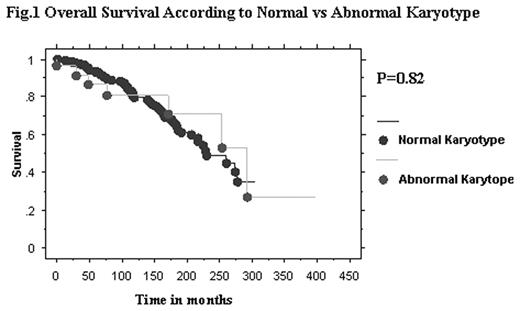Abstract
Objectives: We conducted a study to describe the cytogenetic findings as well as clinical correlates and long-term prognostic relevance of abnormal cytogenetics at the time of diagnosis of Essential thrombocythemia (ET), in terms of clinical presentation, disease transformation into more aggressive myeloid disorders, and life expectancy.
Patients and Methods: The study cohort consisted of a consecutive group of patients with ET who fulfilled the World Health Organization (WHO) diagnostic criteria, in whom bone marrow biopsy was performed at diagnosis, with interpretable cytogenetic analysis obtained in all cases.
Results: A total of 403 patients were studied (median age, 56 years; median follow-up 64 months). The prevalence of abnormal cytogenetics at presentation was 6.7 % (27 of 403). The most common cytogenetic anomalies identified included trisomy 9 (4 patients), trisomy 8 (3 patients) and deletion 20q (3 patients). Parameters at diagnosis that were significantly associated with abnormal cytogenetics included palpable splenomegaly (p=0.03), current tobacco use (p=0.04); venous thrombosis (p= 0.019), extreme thrombocytosis (i.e., platelet count >1500 × 109/L, p = 0.03) and anemia with a hemoglobin of less than 10 g/dl (p=0.02); but did not include Jak2 mutation status, nor advanced age (≥ 60 years). During follow up, patients with abnormal cytogenetics were more likely to experience venous thrombosis (p=0.02) but not shorter survival [figure 1], transformation to AML, MDS or MMM, nor a greater requirement for cytotoxic therapy.
Conclusion: Cytogenetic anomalies at presentation are relatively uncommon in ET, and do not predict a greater predilection towards evolution into more aggressive myeloid disorders, nor inferior survival.
Disclosure: No relevant conflicts of interest to declare.
Author notes
Corresponding author


This feature is available to Subscribers Only
Sign In or Create an Account Close Modal